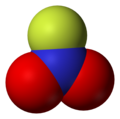| |||
| Identifiers | |||
|---|---|---|---|
3D model (JSmol) | |||
| ChemSpider | |||
| ECHA InfoCard | 100.030.007 | ||
| EC Number |
| ||
PubChem CID | |||
| UNII | |||
CompTox Dashboard (EPA) | |||
| |||
| |||
| Properties | |||
| FNO2 | |||
| Molar mass | 65.003 g·mol−1 | ||
| Melting point | −166 °C (−267 °F; 107 K) | ||
| Boiling point | −72 °C (−98 °F; 201 K) | ||
| Related compounds | |||
Other anions | nitryl chloride, nitryl bromide | ||
Other cations | nitrosyl fluoride, sulfuryl fluoride | ||
Except where otherwise noted, data are given for materials in their standard state (at 25 °C [77 °F], 100 kPa). | |||
Nitryl fluoride is a colourless gas and strong oxidizing agent, which is used as a fluorinating agent [1] and has been proposed as an oxidiser in rocket propellants (though never flown). Its formula is NO2F.
Contents
It is a molecular species, not ionic, consistent with its low boiling point. The structure features planar nitrogen with a short N-F bond length of 135 pm. [2]

